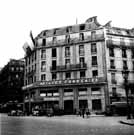
|
|
|

|

|

|

|
|
Click on an image to see a larger, more detailed picture.
|
|
|
|
|
| 1944: Desperate Acts |

|
pg. 517 |

|
|
|
|
| |
 By March 1943 almost all of the Jews living in the Generalgouvernement had been killed. Thus, Heinrich Himmler decided to wind down Operation Reinhard (the extermination of Jews in the area), which officially ended on October 19, 1943. In August the last 25,000 Jews living in the Bialystok Ghetto were transported to Treblinka, where they were murdered. The Nazis closed the camp in the fall, then razed it in order to cover up their crimes. When the Soviets arrived in the region in July 1944, they discovered that a Ukrainian peasant family had moved into a house (pictured) that had been built on the camp's grounds by the SS. The Red Army forced the Ukrainians to move and then burned the house.
By March 1943 almost all of the Jews living in the Generalgouvernement had been killed. Thus, Heinrich Himmler decided to wind down Operation Reinhard (the extermination of Jews in the area), which officially ended on October 19, 1943. In August the last 25,000 Jews living in the Bialystok Ghetto were transported to Treblinka, where they were murdered. The Nazis closed the camp in the fall, then razed it in order to cover up their crimes. When the Soviets arrived in the region in July 1944, they discovered that a Ukrainian peasant family had moved into a house (pictured) that had been built on the camp's grounds by the SS. The Red Army forced the Ukrainians to move and then burned the house.
Photo: Novosty Press / United States Holocaust Memorial Museum Photo Archive
|
 From its headquarters in an imposing building on the corner of a Paris street, the Milice (French militia) was a pro-Nazi paramilitary unit founded in January 1943 at the initiative of Joseph Darnand. It functioned partly as a counterpart to the SS. Charged with internal security in Nazi-occupied France, the militia concentrated on ferreting out Jews and members of the French Resistance.
From its headquarters in an imposing building on the corner of a Paris street, the Milice (French militia) was a pro-Nazi paramilitary unit founded in January 1943 at the initiative of Joseph Darnand. It functioned partly as a counterpart to the SS. Charged with internal security in Nazi-occupied France, the militia concentrated on ferreting out Jews and members of the French Resistance.
Photo: André Zucca/ Bibliothèque Historique de la Ville de Paris
|
 Saly Mayer was a Swiss businessman and president of the Schweizerischer Israelitischer Gemeindebund (Federation of Swiss-Jewish Communities) from 1936 until 1942. He walked the tightrope of negotiating with the Nazis to save Hungarian Jews while refusing the Nazis' requests for resources that would have prolonged the war. In 1940 he became the representative of the Jewish Distribution Committee (JDC) in Switzerland. In that position, he sought to funnel Swiss-Jewish funds to support Jews in occupied countries and to bargain for their release.
Saly Mayer was a Swiss businessman and president of the Schweizerischer Israelitischer Gemeindebund (Federation of Swiss-Jewish Communities) from 1936 until 1942. He walked the tightrope of negotiating with the Nazis to save Hungarian Jews while refusing the Nazis' requests for resources that would have prolonged the war. In 1940 he became the representative of the Jewish Distribution Committee (JDC) in Switzerland. In that position, he sought to funnel Swiss-Jewish funds to support Jews in occupied countries and to bargain for their release.
Photo: American Jewish Joint Distribution Committee/United States Holocaust Memorial Museum Photo Archive
|
|

|

|

|

|
 Spring 1944: The camp system near Stutthof, Germany, is enlarged to include 74 satellite camps.
Spring 1944: The camp system near Stutthof, Germany, is enlarged to include 74 satellite camps.
|
 March 22, 1944: Led by Shlomo Kushnir, nearly 100 Jews escape the labor camp at Koldichevo, Belorussia. Rebels leave behind an explosive charge, which kills ten SS guards. Most escapees avoid capture and join the Bielski resistance group in the Naliboki Forest. Kushnir commits suicide after being captured.
March 22, 1944: Led by Shlomo Kushnir, nearly 100 Jews escape the labor camp at Koldichevo, Belorussia. Rebels leave behind an explosive charge, which kills ten SS guards. Most escapees avoid capture and join the Bielski resistance group in the Naliboki Forest. Kushnir commits suicide after being captured.
|
 March 23, 1944: In the Bialystok region of Poland, a Jewish partisan group led by Andrei Tsymbal destroys a German military train transporting armored cars to the Eastern Front.
March 23, 1944: In the Bialystok region of Poland, a Jewish partisan group led by Andrei Tsymbal destroys a German military train transporting armored cars to the Eastern Front.
|
 March 23, 1944: Nearly 6500 Jews from Greece, including 1687 from Jannina, are deported to Auschwitz.
March 23, 1944: Nearly 6500 Jews from Greece, including 1687 from Jannina, are deported to Auschwitz.
|
 March 24, 1944: Eight hundred Jews from Athens, Greece, are murdered at Auschwitz.
March 24, 1944: Eight hundred Jews from Athens, Greece, are murdered at Auschwitz.
|
 March 24, 1944: Near the catacombs outside Ardea, Italy, near Rome, Germans kill 335 civilians in the Ardeatine Caves as reprisal for anti-Nazi resistance; more than 250 of the victims are Catholic, 78 are Jewish.
March 24, 1944: Near the catacombs outside Ardea, Italy, near Rome, Germans kill 335 civilians in the Ardeatine Caves as reprisal for anti-Nazi resistance; more than 250 of the victims are Catholic, 78 are Jewish.
|
|
|
|
|
| 1944: Desperate Acts |

|
pg. 517 |

|
|
The Holocaust Chronicle
© 2009 Publications International, Ltd.
|
|
